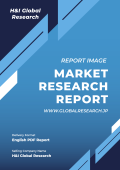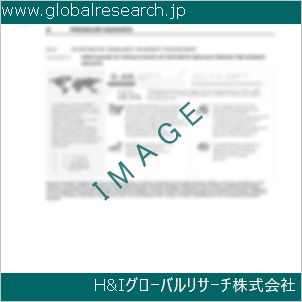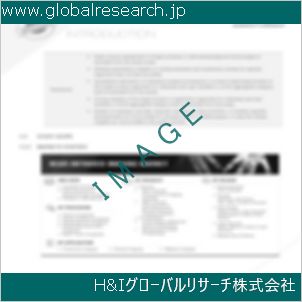目次
第1章 グローバル飲料水吸着剤市場レポートの範囲と方法論
1.1. 研究目的
1.2. 研究方法論
1.2.1. 予測モデル
1.2.2. デスク調査
1.2.3. トップダウンとボトムアップアプローチ
1.3. 研究属性
1.4. 研究の範囲
1.4.1. 市場定義
1.4.2. 市場セグメンテーション
1.5. 研究の仮定
1.5.1. 包含と除外
1.5.2. 制限事項
1.5.3. 調査対象期間
第2章 執行要約
2.1. CEO/CXOの視点
2.2. 戦略的洞察
2.3. ESG分析
2.4. 主要な発見
第3章. グローバル飲料水吸着剤市場動向分析
3.1. グローバル飲料水吸着剤市場を形作る市場要因(2024–2035)
3.2. 推進要因
3.2.1. 厳格な飲料水規制と健康への懸念の高まり
3.2.2. 吸着剤材料と再生方法の技術的進歩
3.3. 制約
3.3.1. 原材料価格の変動と高い製造コスト
3.3.2. 新興経済国におけるインフラの不足
3.4. 機会
3.4.1. ナノ構造化およびハイブリッド複合吸着剤の開発
3.4.2. ポイントオブユースおよび分散型処理システムの拡大
第4章 グローバル飲料水吸着剤産業分析
4.1. ポーターの5つの力モデル
4.1.1. 購入者の交渉力
4.1.2. 供給者の交渉力
4.1.3. 新規参入の脅威
4.1.4. 代替品の脅威
4.1.5. 競合企業の競争
4.2. ポーターの5つの力予測モデル(2024–2035)
4.3. PESTEL分析
4.3.1. 政治
4.3.2. 経済的
4.3.3. 社会
4.3.4. 技術的
4.3.5. 環境
4.3.6. 法的
4.4. 主要な投資機会
4.5. 主要な成功戦略(2025年)
4.6. 市場シェア分析(2024–2025)
4.7. グローバル価格分析と動向(2025年)
4.8. 分析家の推奨事項と結論
第5章. グローバル飲料水吸着剤市場規模と予測(吸着剤タイプ別)2025–2035
5.1. 市場概要
5.2. 潜在分析(2025年)
5.3. 炭素
5.3.1. 主要国別内訳推計と予測(2024–2035)
5.3.2. 地域別市場規模分析(2025~2035年)
5.4. 活性炭
5.4.1. 主要国別内訳推計と予測(2024~2035年)
5.4.2. 地域別市場規模分析、2025–2035
5.5. 活性アルミニウム
5.5.1. 主要国別内訳推計と予測(2024年~2035年)
5.5.2. 地域別市場規模分析、2025–2035
5.6. シリカゲル
5.6.1. 主要国別内訳推計と予測(2024~2035年)
5.6.2. 地域別市場規模分析、2025–2035
5.7. イオン交換樹脂
5.7.1. 主要国別内訳推計と予測(2024年~2035年)
5.7.2. 地域別市場規模分析、2025–2035
第6章. グローバル飲料水吸着剤市場規模と予測(用途別、形状別、浄化目的別)、2025–2035
6.1. 市場概要
6.2. 潜在分析(2025年)
6.3. 用途別
6.3.1. ポイントオブユース(POU)水フィルターシステム
6.3.2. 産業用水処理
6.3.3. 自治体用水処理
6.4. 形態別
6.4.1. 粒状
6.4.2. 粉末型
6.4.3. 押出成形
6.4.4. 含浸型
6.5. 精製目的別
6.5.1. 不純物除去
6.5.2. 色の除去
6.5.3. 臭気除去
6.5.4. 味除去
第7章. グローバル飲料水吸着剤市場規模と地域別予測(2025~2035年)
7.1. 地域別市場概要
7.2. 主要なリーダー企業と新興国
7.3. 北米市場
7.3.1. 米国市場
7.3.1.1. タイプ、用途、および形態別市場規模と予測(2025–2035年)
7.3.1.2. 国別分析
7.3.2. カナダ市場
7.3.2.1. タイプ、用途およびフォームファクター別市場規模と予測(2025年~2035年)
7.3.2.2. 国別動向
7.4. 欧州市場
7.4.1. イギリス市場
7.4.1.1. 種類、用途およびフォームファクター別市場規模と予測(2025年~2035年)
7.4.1.2. 国別動向
7.4.2. ドイツ市場
7.4.2.1. タイプ、用途およびフォームファクター別市場規模と予測(2025年~2035年)
7.4.2.2. 国別動向
7.4.3. フランス市場
7.4.3.1. タイプ、用途およびフォームファクター別市場規模と予測(2025年~2035年)
7.4.3.2. 国別動向
7.4.4. スペイン市場
7.4.4.1. タイプ、用途、およびフォームファクター別市場規模と予測(2025年~2035年)
7.4.4.2. 国別動向
7.4.5. イタリア市場
7.4.5.1. タイプ、用途およびフォームファクター別市場規模と予測(2025年~2035年)
7.4.5.2. 国別動向
7.4.6. 欧州その他の市場
7.4.6.1. タイプ、用途およびフォームファクター別市場規模と予測(2025年~2035年)
7.4.6.2. 国別動向
7.5. アジア太平洋市場
7.5.1. 中国市場
7.5.1.1. タイプ、用途およびフォームファクター別市場規模と予測(2025~2035年)
7.5.1.2. 国別動向
7.5.2. インド市場
7.5.2.1. タイプ、用途およびフォームファクター別市場規模と予測(2025~2035年)
7.5.2.2. 国別動向
7.5.3. 日本市場
7.5.3.1. タイプ、用途およびフォームファクター別市場規模と予測(2025年~2035年)
7.5.3.2. 国別動向
7.5.4. オーストラリア市場
7.5.4.1. タイプ、用途およびフォームファクター別市場規模と予測(2025年~2035年)
7.5.4.2. 国別動向
7.5.5. 韓国市場
7.5.5.1. タイプ、用途およびフォームファクター別市場規模と予測(2025~2035年)
7.5.5.2. 国別動向
7.5.6. アジア太平洋地域その他の市場
7.5.6.1. タイプ、用途、およびフォームファクター別市場規模と予測(2025年~2035年)
7.5.6.2. 国別動向
7.6. ラテンアメリカ市場
7.6.1. ブラジル市場
7.6.1.1. タイプ、用途およびフォームファクター別市場規模と予測(2025~2035年)
7.6.1.2. 国別動向
7.6.2. メキシコ市場
7.6.2.1. タイプ、用途およびフォームファクター別市場規模と予測(2025年~2035年)
7.6.2.2. 国別動向
7.6.3. ラテンアメリカその他の市場
7.6.3.1. タイプ、用途、およびフォームファクター別市場規模と予測(2025~2035年)
7.6.3.2. 国別動向
7.7. 中東・アフリカ市場
7.7.1. アラブ首長国連邦(UAE)市場
7.7.1.1. タイプ、用途およびフォームファクター別市場規模と予測(2025~2035年)
7.7.1.2. 国別動向
7.7.2. サウジアラビア市場
7.7.2.1. タイプ、用途、およびフォームファクター別市場規模と予測(2025年~2035年)
7.7.2.2. 国別動向
7.7.3. 南アフリカ市場
7.7.3.1. タイプ、用途およびフォームファクター別市場規模と予測(2025年~2035年)
7.7.3.2. 国別動向
7.7.4. 中東・アフリカその他の市場
7.7.4.1. タイプ、用途、およびフォームファクター別市場規模と予測(2025~2035年)
7.7.4.2. 国別動向
第8章 競合分析
8.1. 主要な市場戦略
8.2. ヴェオリア・ウォーター・テクノロジーズ
8.2.1. 当社概要
8.2.2. 主要な経営陣
8.2.3. 会社の概要
8.2.4. 財務実績(データ入手状況により異なります)
8.2.5. 製品/サービスポートフォリオ
8.2.6. 最近の動向
8.2.7. 市場戦略
8.2.8. SWOT分析
8.3. Lenntech B.V.
8.4. キャボット・コーポレーション
8.5. カルゴン・カーボン・コーポレーション
8.6. エヴォクア・ウォーター・テクノロジーズ
8.7. クラレ株式会社
8.8. サーマックス・リミテッド
8.9. BASF SE
8.10. デュポン・デ・ネムール株式会社
8.11. ケミラ・オイジ
8.12. ドナウ・ケミエ AG
8.13. ピュロライト・コーポレーション
8.14. アクロ・オーガニクス・リミテッド
8.15. レジンテック・インク
8.16. ヤコビ・カーボンズ・エービー
8.12. ドナウ・ケミエ AG
表の一覧
表1. グローバル飲料水吸着剤市場レポートの範囲
表2. グローバル飲料水用吸着剤市場規模推計および地域別予測(2024–2035年)
表3. グローバル飲料水吸着剤市場規模推計および予測(吸着剤タイプ別)2024–2035
表4. グローバル飲料水吸着剤市場規模推計および予測(用途別)2024–2035
表5. グローバル飲料水吸着剤市場規模予測(形状要因および浄化目的別)2024–2035
表6. 北米市場規模推計と予測、2024–2035
表7. 米国市場規模推計と予測(2024–2035年)
表8. カナダ市場規模予測(2024~2035年)
表9. 欧州市場規模予測(2024年~2035年)
表10. イギリス市場の見積もりおよび予測、2024–2035
表11. ドイツ市場の見積もりおよび予測、2024–2035
表12. フランス市場の見積もりおよび予測、2024–2035
表13. スペイン市場の見積もりおよび予測、2024–2035
表14. イタリア市場の見積もりおよび予測、2024–2035
表15. 欧州その他の地域市場推定値と予測、2024–2035
表16. アジア太平洋地域市場推定値と予測、2024–2035
表17. 中国市場の見積もりおよび予測、2024–2035
表18. インド市場の見積もりおよび予測、2024–2035
表19. 日本市場の見積もりおよび予測、2024–2035
表20. オーストラリア市場の見積もりおよび予測、2024–2035
表21. 韓国市場の見積もりおよび予測、2024–2035
表22. ラテンアメリカ市場推定値と予測、2024–2035
表23. ブラジル市場の見積もりおよび予測、2024–2035
表24. メキシコ市場の見積もりおよび予測、2024–2035
表25. 中東・アフリカ市場の見積もりおよび予測、2024–2035
表26. アラブ首長国連邦(UAE)市場予測と推計、2024–2035
表27. サウジアラビア市場推定値と予測、2024–2035
表28. 南アフリカ市場推計と予測、2024–2035
図表一覧
図1. グローバル飲料水吸着剤市場調査手法
図2. 市場推定手法
図3. グローバル市場規模推計および予測方法
図4. 飲料水用吸着剤の主要な動向(2025年)
図5. 成長見通し(2024年~2035年)
図6. ポーターの5つの力モデル
図7. PESTEL分析
図8. バリューチェーン分析
図9. 吸着剤の種類別市場規模(2025年と2035年)
図10. 用途、フォームファクターおよび精製目的別内訳、2025年と2035年
図11. 地域別市場概況、2025年と2035年
図12. 北米市場、2025年と2035年
図13. 欧州市場、2025年と2035年
図14. アジア太平洋市場、2025年と2035年
図15. ラテンアメリカ市場、2025年と2035年
図16. 中東・アフリカ市場、2025年と2035年
図17. 企業別市場シェア分析(2025年)
Chapter 1. Global Drinking Water Adsorbents Market Report Scope & Methodology
1.1. Research Objective
1.2. Research Methodology
1.2.1. Forecast Model
1.2.2. Desk Research
1.2.3. Top-Down and Bottom-Up Approach
1.3. Research Attributes
1.4. Scope of the Study
1.4.1. Market Definition
1.4.2. Market Segmentation
1.5. Research Assumptions
1.5.1. Inclusion & Exclusion
1.5.2. Limitations
1.5.3. Years Considered for the Study
Chapter 2. Executive Summary
2.1. CEO/CXO Standpoint
2.2. Strategic Insights
2.3. ESG Analysis
2.4. Key Findings
Chapter 3. Global Drinking Water Adsorbents Market Forces Analysis
3.1. Market Forces Shaping the Global Drinking Water Adsorbents Market (2024–2035)
3.2. Drivers
3.2.1. Stricter Drinking Water Regulations and Growing Health Concerns
3.2.2. Technological Advances in Adsorbent Materials and Regeneration Methods
3.3. Restraints
3.3.1. Volatile Raw Material Prices and High Production Costs
3.3.2. Limited Infrastructure in Emerging Economies
3.4. Opportunities
3.4.1. Development of Nanostructured and Hybrid Composite Adsorbents
3.4.2. Expansion of Point-of-Use and Decentralized Treatment Systems
Chapter 4. Global Drinking Water Adsorbents Industry Analysis
4.1. Porter’s Five Forces Model
4.1.1. Bargaining Power of Buyers
4.1.2. Bargaining Power of Suppliers
4.1.3. Threat of New Entrants
4.1.4. Threat of Substitutes
4.1.5. Competitive Rivalry
4.2. Porter’s Five Forces Forecast Model (2024–2035)
4.3. PESTEL Analysis
4.3.1. Political
4.3.2. Economic
4.3.3. Social
4.3.4. Technological
4.3.5. Environmental
4.3.6. Legal
4.4. Top Investment Opportunities
4.5. Top Winning Strategies (2025)
4.6. Market Share Analysis (2024–2025)
4.7. Global Pricing Analysis and Trends (2025)
4.8. Analyst Recommendations & Conclusion
Chapter 5. Global Drinking Water Adsorbents Market Size & Forecasts by Adsorbent Type 2025–2035
5.1. Market Overview
5.2. Potential Analysis (2025)
5.3. Carbon
5.3.1. Top Countries Breakdown Estimates & Forecasts, 2024–2035
5.3.2. Market Size Analysis, by Region, 2025–2035
5.4. Activated Carbon
5.4.1. Top Countries Breakdown Estimates & Forecasts, 2024–2035
5.4.2. Market Size Analysis, by Region, 2025–2035
5.5. Activated Alumina
5.5.1. Top Countries Breakdown Estimates & Forecasts, 2024–2035
5.5.2. Market Size Analysis, by Region, 2025–2035
5.6. Silica Gel
5.6.1. Top Countries Breakdown Estimates & Forecasts, 2024–2035
5.6.2. Market Size Analysis, by Region, 2025–2035
5.7. Ion Exchange Resins
5.7.1. Top Countries Breakdown Estimates & Forecasts, 2024–2035
5.7.2. Market Size Analysis, by Region, 2025–2035
Chapter 6. Global Drinking Water Adsorbents Market Size & Forecasts by Application, Form Factor & Purification Purpose 2025–2035
6.1. Market Overview
6.2. Potential Analysis (2025)
6.3. By Application
6.3.1. Point-of-Use (POU) Water Filtration Systems
6.3.2. Industrial Water Treatment
6.3.3. Municipal Water Treatment
6.4. By Form Factor
6.4.1. Granular
6.4.2. Powdered
6.4.3. Extruded
6.4.4. Impregnated
6.5. By Purification Purpose
6.5.1. Removal of Impurities
6.5.2. Color Removal
6.5.3. Odor Removal
6.5.4. Taste Removal
Chapter 7. Global Drinking Water Adsorbents Market Size & Forecasts by Region 2025–2035
7.1. Regional Market Snapshot
7.2. Top Leading & Emerging Countries
7.3. North America Market
7.3.1. U.S. Market
7.3.1.1. Type, Application & Form Factor Breakdown Size & Forecasts, 2025–2035
7.3.1.2. Country-Level Insights
7.3.2. Canada Market
7.3.2.1. Type, Application & Form Factor Breakdown Size & Forecasts, 2025–2035
7.3.2.2. Country-Level Insights
7.4. Europe Market
7.4.1. UK Market
7.4.1.1. Type, Application & Form Factor Breakdown Size & Forecasts, 2025–2035
7.4.1.2. Country-Level Insights
7.4.2. Germany Market
7.4.2.1. Type, Application & Form Factor Breakdown Size & Forecasts, 2025–2035
7.4.2.2. Country-Level Insights
7.4.3. France Market
7.4.3.1. Type, Application & Form Factor Breakdown Size & Forecasts, 2025–2035
7.4.3.2. Country-Level Insights
7.4.4. Spain Market
7.4.4.1. Type, Application & Form Factor Breakdown Size & Forecasts, 2025–2035
7.4.4.2. Country-Level Insights
7.4.5. Italy Market
7.4.5.1. Type, Application & Form Factor Breakdown Size & Forecasts, 2025–2035
7.4.5.2. Country-Level Insights
7.4.6. Rest of Europe Market
7.4.6.1. Type, Application & Form Factor Breakdown Size & Forecasts, 2025–2035
7.4.6.2. Country-Level Insights
7.5. Asia Pacific Market
7.5.1. China Market
7.5.1.1. Type, Application & Form Factor Breakdown Size & Forecasts, 2025–2035
7.5.1.2. Country-Level Insights
7.5.2. India Market
7.5.2.1. Type, Application & Form Factor Breakdown Size & Forecasts, 2025–2035
7.5.2.2. Country-Level Insights
7.5.3. Japan Market
7.5.3.1. Type, Application & Form Factor Breakdown Size & Forecasts, 2025–2035
7.5.3.2. Country-Level Insights
7.5.4. Australia Market
7.5.4.1. Type, Application & Form Factor Breakdown Size & Forecasts, 2025–2035
7.5.4.2. Country-Level Insights
7.5.5. South Korea Market
7.5.5.1. Type, Application & Form Factor Breakdown Size & Forecasts, 2025–2035
7.5.5.2. Country-Level Insights
7.5.6. Rest of Asia Pacific Market
7.5.6.1. Type, Application & Form Factor Breakdown Size & Forecasts, 2025–2035
7.5.6.2. Country-Level Insights
7.6. Latin America Market
7.6.1. Brazil Market
7.6.1.1. Type, Application & Form Factor Breakdown Size & Forecasts, 2025–2035
7.6.1.2. Country-Level Insights
7.6.2. Mexico Market
7.6.2.1. Type, Application & Form Factor Breakdown Size & Forecasts, 2025–2035
7.6.2.2. Country-Level Insights
7.6.3. Rest of Latin America Market
7.6.3.1. Type, Application & Form Factor Breakdown Size & Forecasts, 2025–2035
7.6.3.2. Country-Level Insights
7.7. Middle East & Africa Market
7.7.1. UAE Market
7.7.1.1. Type, Application & Form Factor Breakdown Size & Forecasts, 2025–2035
7.7.1.2. Country-Level Insights
7.7.2. Saudi Arabia Market
7.7.2.1. Type, Application & Form Factor Breakdown Size & Forecasts, 2025–2035
7.7.2.2. Country-Level Insights
7.7.3. South Africa Market
7.7.3.1. Type, Application & Form Factor Breakdown Size & Forecasts, 2025–2035
7.7.3.2. Country-Level Insights
7.7.4. Rest of Middle East & Africa Market
7.7.4.1. Type, Application & Form Factor Breakdown Size & Forecasts, 2025–2035
7.7.4.2. Country-Level Insights
Chapter 8. Competitive Intelligence
8.1. Top Market Strategies
8.2. Veolia Water Technologies
8.2.1. Company Overview
8.2.2. Key Executives
8.2.3. Company Snapshot
8.2.4. Financial Performance (Subject to Data Availability)
8.2.5. Product/Services Portfolio
8.2.6. Recent Developments
8.2.7. Market Strategies
8.2.8. SWOT Analysis
8.3. Lenntech B.V.
8.4. Cabot Corporation
8.5. Calgon Carbon Corporation
8.6. Evoqua Water Technologies
8.7. Kuraray Co., Ltd.
8.8. Thermax Limited
8.9. BASF SE
8.10. DuPont de Nemours, Inc.
8.11. Kemira Oyj
8.12. Donau Chemie AG
8.13. Purolite Corporation
8.14. ACURO Organics Limited
8.15. ResinTech Inc.
8.16. Jacobi Carbons AB
❖ 免責事項 ❖
http://www.globalresearch.jp/disclaimer












